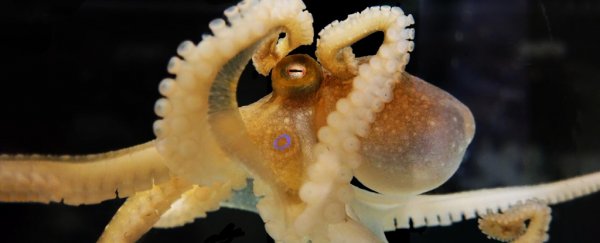Squishy cephalopods never cease to amaze with their clever features, including brained arms, color-shifting camouflage, escape artistry, and puzzle-solving skills. New analyses of squid, octopus, and cuttlefish (coleoid) genetics reveal their genomes are just as deliciously weird as the animals themselves.
The cephalopod genome "is incredibly churned up," says developmental biologist Caroline Albertin, who led one of two new studies identifying strange twists in these cephalopods' genetic histories.
In a massive effort, Albertin and colleagues sequenced three soft-bodied cephalopod genomes: the California two-spot octopus (Octopus bimaculoides) – the first octopus to have its genome sequenced back in 2005; the Atlantic longfin inshore squid (Doryteuthis pealeii) – studied as a model system for neuroscience for nearly a century; and Hawaiian bobtail squid (Euprymna scolopes) – a model animal for bacteria-animal symbiosis.
 Hawaiian bobtail squid making use of its color gene clusters. (David_Slater/iStock/Getty Images Plus)
Hawaiian bobtail squid making use of its color gene clusters. (David_Slater/iStock/Getty Images Plus)
The researchers found a bunch of new gene families, many expressed in the squid brain, as well as expansions in genes we're already familiar with, like clusters of genes involved with cephalopods' shifting coloration, their suckers, and beaks.
Other unique gene expansions include the protocadherin genes that may be involved in building complex nervous systems in both humans and cephalopods. The cephalopods, however, create diversity in this gene through whole copies of it (in humans, this variation comes about in the different ways the genes are expressed).
These copies helped cephalopod genomes get big, with the Doryteuthis's genome weighing in at around 1.5 times larger than ours and the California two-spot octopus's around 90 percent the size of ours.
In contrast, our genomes expanded through the process of whole genome duplication – a feature credited for our advanced complexity and its ability to create new evolutionary features. Cephalopods appear to have undergone similarly large-scale changes, but as with many things they do, they've added their unique flavor.
"We now know that the evolution of soft-bodied cephalopods involved similarly massive genome changes, but the changes are not whole-genome duplications but rather immense genome rearrangements, as if the ancestral genomes were put in a blender," explains University of Chicago neurobiologist Clifton Ragsdale.
 The Atlantic longfin inshore squid. (Elaine Bearer)
The Atlantic longfin inshore squid. (Elaine Bearer)
This genetic shuffling may have dealt these unique sea beasties with their impressive hand of cognitive abilities, blessing them with the largest nervous systems of all invertebrates. Between their arms and their heads, octopus's roughly 500 million neurons rival the amount possessed by dogs.
"We compared the squid genome to that of a scallop, and we found that many genes that were scattered in the scallop genome had come together on specific areas of the squid chromosomes. These new gene clusters form regulatory units. This means that they can interact with each other and alter the animal's physiology," says molecular pathologist Akane Kawaguchi, co-lead author of the second study that took a closer look at the bobtail squid's genome.
"One of the gene clusters in the squid genome contains five major genes involved in the development of the nervous system."
The clustering of associated genes allowed for streamlining and unique forms of genetic regulation.
 The California two-spot octopus. (Tom Kleindinst)
The California two-spot octopus. (Tom Kleindinst)
And last but not least, there is the cephalopod's famous ability to edit their own brain genes. This messenger RNA editing ability occurs in only a handful of important nervous system proteins in humans, in less than 1 percent, but in cephalopods, it is far more widespread.
Usually, changes to an animal's construction happen with mutations in its DNA blueprints. But in this case, the messenger RNA – which does the protein building – is the one making the changes. There's some suggestion this ability allows cephalopods more flexibility to adapt rapidly to their environment, with the builder able to improvise to suit new conditions, but this is still not entirely established.
Albertin and her team found the animals' RNA editing falls into two distinct categories, neural and non-neural edits. Not only do these occur in different tissues but the frequency in which editing occurs is also dramatically different, with editing associated with the nervous system happening far more frequently, suggesting it is extremely important to how these animals function.
These unusual mechanisms have all contributed to building the alien intelligences we now all marvel at, in the 300 million years since squid and octopus last shared a common ancestor. We can't wait to see what else their strange genomes will reveal.
This research was published here and here in Nature Communications.
